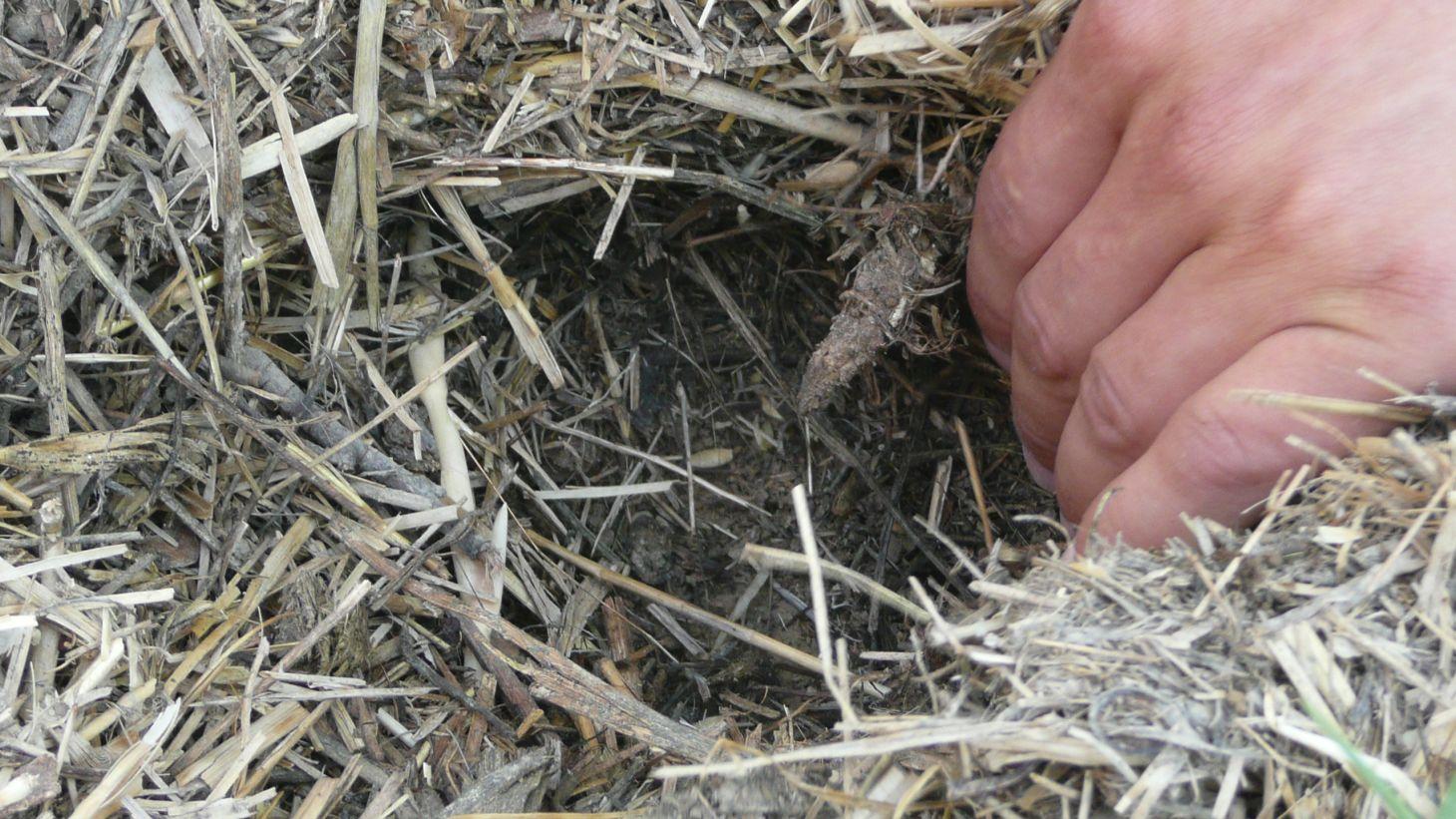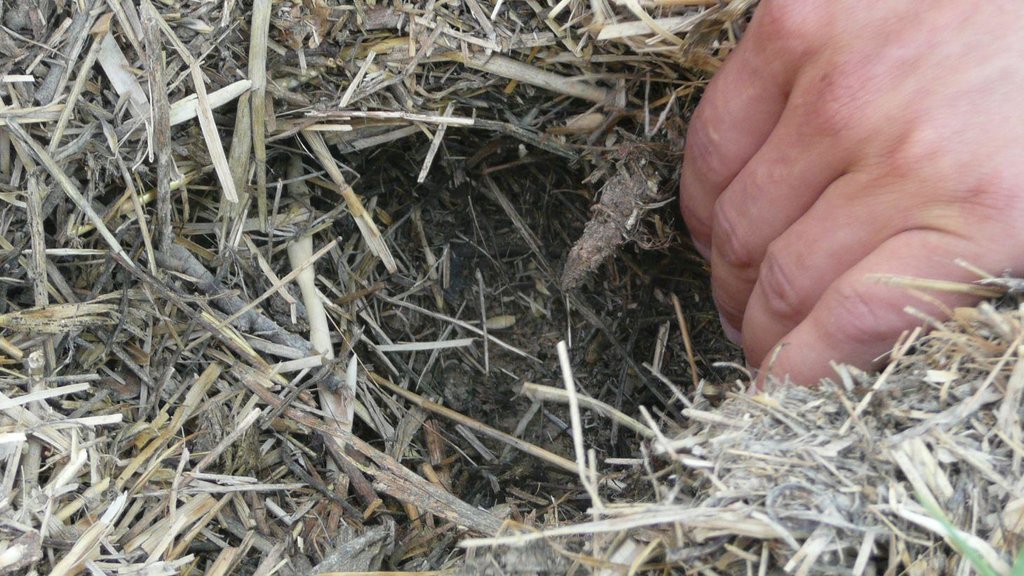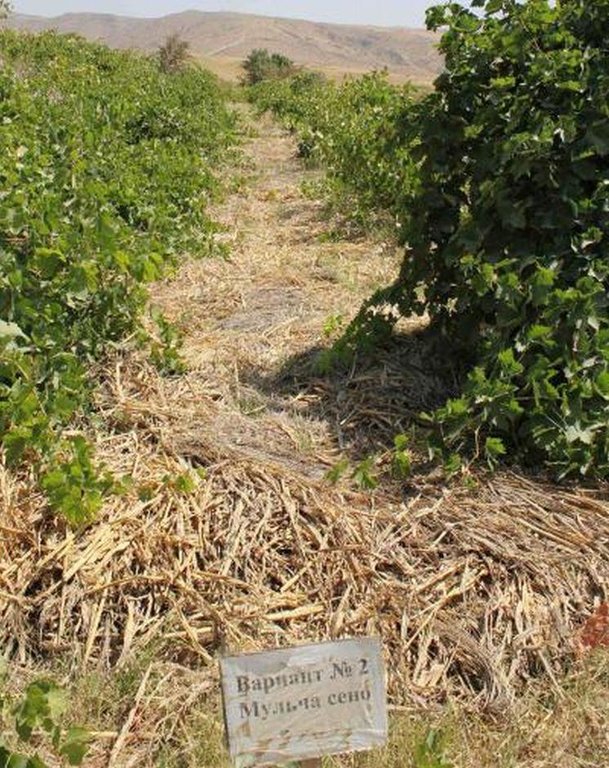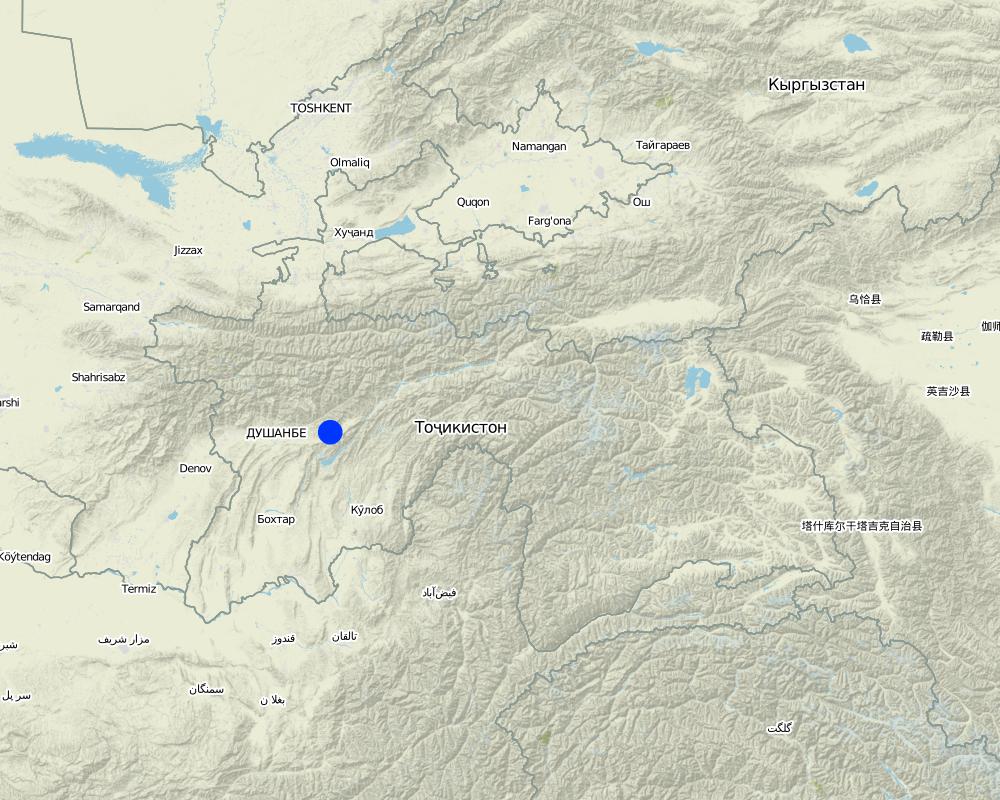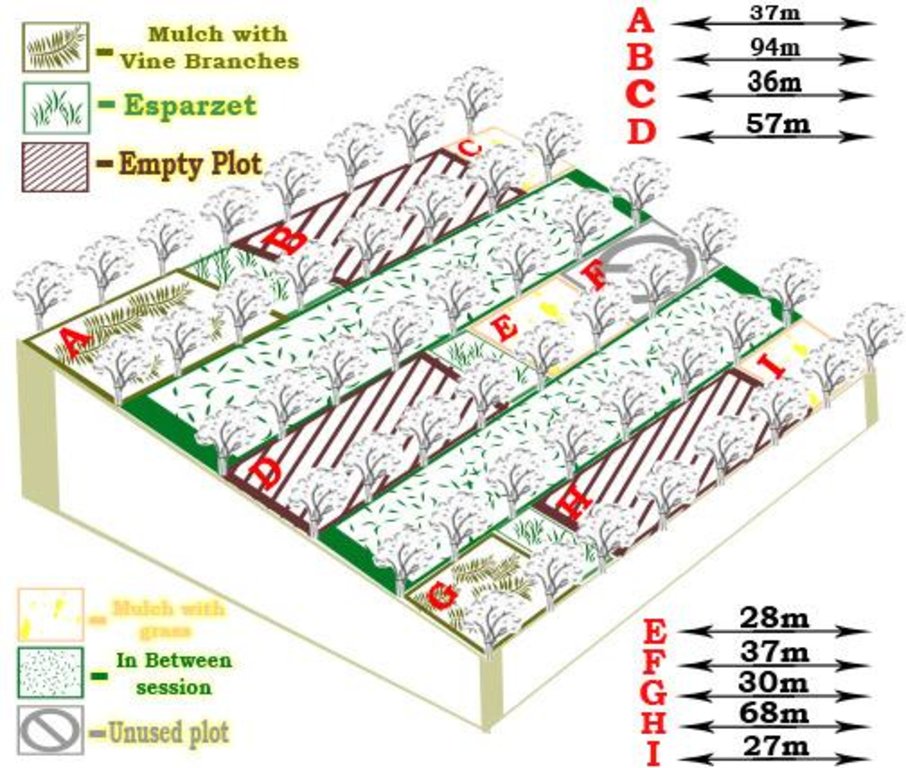Mulching in rainfed vineyards on terraces in the loess hill zone [Tajikistan]
- Creation:
- Update:
- Compiler: Qobiljon Shokirov
- Editor: –
- Reviewers: David Streiff, Alexandra Gavilano
Mulcha Sino
technologies_1111 - Tajikistan
View sections
Expand all Collapse all1. General information
1.2 Contact details of resource persons and institutions involved in the assessment and documentation of the Technology
SLM specialist:
Boev Jahonbek
Tajik Soil Institute
Tajikistan
Name of the institution(s) which facilitated the documentation/ evaluation of the Technology (if relevant)
Tajik Soil Insitute (Tajik Soil Institute) - TajikistanName of the institution(s) which facilitated the documentation/ evaluation of the Technology (if relevant)
NCCR North-South (NCCR North-South) - Kyrgyzstan1.3 Conditions regarding the use of data documented through WOCAT
The compiler and key resource person(s) accept the conditions regarding the use of data documented through WOCAT:
Yes
2. Description of the SLM Technology
2.1 Short description of the Technology
Definition of the Technology:
This technology consists of vineyards plots that are mulched with grass and established on terraced land in the loess hills of Tajikistan.
2.2 Detailed description of the Technology
Description:
On the terrain of the Tajik Soil Institut's research station in Karsang, Faizabad District, Tajikistan, a vineyard was established on forward sloping terraces with about 12° inclination on land formerly used as extensive pastures. This technology dates back to the times of the Soviet Union in 1968. Bulldozers were used to establish the terraces.
Before the planting of vines the soil was ploughed. Local vine sorts were used for the plantation and intercropping is done with wheat and fodder crops. About 1300 vine seedlings were planted per hectare.
Purpose of the Technology: Mulching treatment with grass was initiated to increase soil moisture in the soil, improve soil quality such as soil organic matter and other elements and protect soil from erosion by water and wind.
Establishment / maintenance activities and inputs: Mulching with grass was set up by the Tajik Soil Institute and but has been maintained by the farmers who lease the land. Mulching with grass is relatively easy but can be very challenging; depending on the availability of resources. First, plots between the vineyard rows were ploughed by using animal power, in most cases horses. Natural grasses were cut from the property of the research station and applied as a mulch in between plots within the designated vineyard plots. Since then the experiment has been maintained by the farmers and over the last ten years layer of mulch with grass has been growing and building up the top soil layer. This layer of mulch prevents rainwater from eroding the top soil, improves soil organic carbon, provides shade to plant roots, and most importantly keeps soil moisture moderately in hot summer months, which is very essential in these rainfed areas.
Natural / human environment: The terraces have greatly helped to reduced soil erosion and the vines supported this effect in further stabilising the soil. Soil humidity has improved through increased soil moisture and reduced evaporation due to mulching throughout the year. As the vineyard was established on pasture land, a disadvantage is the reduced grazing land area. The disadvantage of mulching is that no inter cropping between the vines can take place for several years.
In summer of 2011, WOCAT questionnary was used to analyze and evaluate current conditions of the vineyard mulching treatment. At the same time proper soil samples were taken from the plots with mulch and control plots in 0-15 and 15-30cm for further comparison for soil organic carbon (SOC). All together 240 soil samples were taken from eight different plots and each have been analyzed for soil SOC content.
From this study it was revealed that plots with mulch has significantly higher SOC content than control plots. In average, plots with mulch consisted of 1.3% SOC and control plots in average contained 0.4% SOC within the 0-15cm depths. Average SOC content for plots with mulch and control plots were observed but there were no significant difference in 30cm depth, both contained 0.4-0.5% of SOC.
2.3 Photos of the Technology
2.5 Country/ region/ locations where the Technology has been applied and which are covered by this assessment
Country:
Tajikistan
Region/ State/ Province:
RRS
Further specification of location:
Faizabad, Javonon, Karsang
Specify the spread of the Technology:
- evenly spread over an area
If precise area is not known, indicate approximate area covered:
- < 0.1 km2 (10 ha)
Comments:
Total area covered by the SLM Technology is 0.07 km2.
Map
×2.6 Date of implementation
If precise year is not known, indicate approximate date:
- less than 10 years ago (recently)
2.7 Introduction of the Technology
Specify how the Technology was introduced:
- during experiments/ research
Comments (type of project, etc.):
The vineyard was originally set up 60 years ago but the mulching experiment within the vineyard was introduced around 2000-2003.
3. Classification of the SLM Technology
3.1 Main purpose(s) of the Technology
- reduce, prevent, restore land degradation
3.2 Current land use type(s) where the Technology is applied
Land use mixed within the same land unit:
Yes
Specify mixed land use (crops/ grazing/ trees):
- Agroforestry

Cropland
- Perennial (non-woody) cropping
- Tree and shrub cropping
Tree and shrub cropping - Specify crops:
- grapes
Number of growing seasons per year:
- 1
Specify:
Longest growing period from month to month: April to November

Grazing land

Forest/ woodlands
Comments:
Major land use problems (compiler’s opinion): soil erosion through wind and water, soil moisture loss, soil nutrient mining
Major land use problems (land users’ perception): soil fertility and humidity decline, lack of technical equipment, low productivity of non-irrigated land on slopes when used in a conventional way as cropland of extensive pasture
Future (final) land use (after implementation of SLM Technology): Mixed: Mf: Agroforestry
3.3 Has land use changed due to the implementation of the Technology?
Has land use changed due to the implementation of the Technology?
- Yes (Please fill out the questions below with regard to the land use before implementation of the Technology)
Land use mixed within the same land unit:
Yes
Specify mixed land use (crops/ grazing/ trees):
- Agroforestry

Grazing land
Comments:
Future (final) land use (after implementation of SLM Technology): Mixed: Mf: Agroforestry
3.4 Water supply
Water supply for the land on which the Technology is applied:
- rainfed
3.5 SLM group to which the Technology belongs
- agroforestry
- improved ground/ vegetation cover
- cross-slope measure
3.6 SLM measures comprising the Technology

agronomic measures
- A1: Vegetation/ soil cover
- A3: Soil surface treatment
A3: Differentiate tillage systems:
A 3.1: No tillage

vegetative measures
- V1: Tree and shrub cover

structural measures
- S1: Terraces

management measures
- M1: Change of land use type
Comments:
Main measures: agronomic measures, vegetative measures
Secondary measures: structural measures, management measures
Type of agronomic measures: mulching, breaking compacted topsoil, zero tillage / no-till
Type of vegetative measures: aligned: -contour
3.7 Main types of land degradation addressed by the Technology

soil erosion by water
- Wt: loss of topsoil/ surface erosion
- Wg: gully erosion/ gullying
Comments:
Main type of degradation addressed: Wt: loss of topsoil / surface erosion
Secondary types of degradation addressed: Wg: gully erosion / gullying
Main causes of degradation: soil management (Plowing), overgrazing, Heavy / extreme rainfall (intensity/amounts)
Secondary causes of degradation: wind storms / dust storms, droughts, governance / institutional (common grazing land in the vicinity of the village regulated management)
3.8 Prevention, reduction, or restoration of land degradation
Specify the goal of the Technology with regard to land degradation:
- prevent land degradation
- reduce land degradation
Comments:
Main goals: prevention of land degradation
Secondary goals: mitigation / reduction of land degradation, rehabilitation / reclamation of denuded land
4. Technical specifications, implementation activities, inputs, and costs
4.1 Technical drawing of the Technology
Technical specifications (related to technical drawing):
ocation: Faizabad, Tajikistan. RRS
Date: September, 2011
Technical knowledge required for field staff / advisors: moderate
Technical knowledge required for land users: moderate
Main technical functions: control of raindrop splash, control of dispersed runoff: impede / retard, improvement of ground cover, increase in organic matter, increase in nutrient availability (supply, recycling,…), increase / maintain water stored in soil
Secondary technical functions: control of dispersed runoff: retain / trap, improvement of surface structure (crusting, sealing), stabilisation of soil (eg by tree roots against land slides), increase of infiltration, water harvesting / increase water supply, increase of biomass (quantity)
Diversion ditch/ drainage
Material: earth
Mulching
Material/ species: grass
Quantity/ density: 15-20cm
Remarks: mulch layer thickness (15-20cm)
Breaking compacted topsoil
Material/ species: loosing of soil around vines, yearly
Zero tillage / no-till
Material/ species: zero tillage between the vines on the terraces
Aligned: -contour
Vegetative material: F : fruit trees / shrubs
Number of plants per (ha): 1300
Spacing between rows / strips / blocks (m): 3
Vertical interval within rows / strips / blocks (m): 2
Fruit trees / shrubs species: vineyards "rosevitaiti", improved local sorts
Terrace: bench level
Width of bunds/banks/others (m): 3
Vegetation is used for stabilisation of structures.
Author:
Ibrohimov Huseyn
4.2 General information regarding the calculation of inputs and costs
Specify currency used for cost calculations:
- USD
If relevant, indicate exchange rate from USD to local currency (e.g. 1 USD = 79.9 Brazilian Real): 1 USD =:
-2.13
Indicate average wage cost of hired labour per day:
6.5
4.3 Establishment activities
| Activity | Timing (season) | |
|---|---|---|
| 1. | Planting | |
| 2. | Terracing by bulldozer | late autumn / early spring |
4.4 Costs and inputs needed for establishment
| Specify input | Unit | Quantity | Costs per Unit | Total costs per input | % of costs borne by land users | |
|---|---|---|---|---|---|---|
| Labour | Planting | Persons/day | 13.0 | 6.5 | 84.5 | |
| Labour | Terracing by bulldozer | hours | 16.0 | 2.81222 | 45.0 | |
| Equipment | Bulldozer rent | hours | 16.0 | 0.8125 | 13.0 | |
| Plant material | Seedlings | Seeds/ha | 1300.0 | 0.5 | 650.0 | |
| Fertilizers and biocides | Fertilizer | kg | 5.0 | 1.0 | 5.0 | |
| Construction material | Grass | tons | 1.0 | 165.0 | 165.0 | |
| Total costs for establishment of the Technology | 962.5 | |||||
| Total costs for establishment of the Technology in USD | -451.88 | |||||
4.5 Maintenance/ recurrent activities
| Activity | Timing/ frequency | |
|---|---|---|
| 1. | cutting of grass | spring/once a year |
| 2. | soil loosening around the trees | |
| 3. | Mulching | spring (end of April/beginning of May) |
| 4. | Cutting the grass | 1 |
| 5. | Protecting the vineyard from animals | autumn to spring |
4.6 Costs and inputs needed for maintenance/ recurrent activities (per year)
| Specify input | Unit | Quantity | Costs per Unit | Total costs per input | % of costs borne by land users | |
|---|---|---|---|---|---|---|
| Labour | Cutting of grass | Persons/day | 5.0 | 6.5 | 32.5 | |
| Labour | Soil loosening | Persons/day | 2.0 | 6.5 | 13.0 | |
| Labour | Cutting the grass 2nd time | Persons/day | 4.0 | 6.5 | 26.0 | |
| Equipment | Mulching | tons | 1.0 | 86.0 | 86.0 | |
| Equipment | Scissors | ha | 1.0 | 60.0 | 60.0 | |
| Total costs for maintenance of the Technology | 217.5 | |||||
| Total costs for maintenance of the Technology in USD | -102.11 | |||||
Comments:
Machinery/ tools: scissors, hoes
The establishment of the vineyard took place in Soviet times and costs were born by the Soil Institute, which is a state institution. However, costs were calculated based on current costs (2011).
5. Natural and human environment
5.1 Climate
Annual rainfall
- < 250 mm
- 251-500 mm
- 501-750 mm
- 751-1,000 mm
- 1,001-1,500 mm
- 1,501-2,000 mm
- 2,001-3,000 mm
- 3,001-4,000 mm
- > 4,000 mm
Agro-climatic zone
- semi-arid
Thermal climate class: temperate
5.2 Topography
Slopes on average:
- flat (0-2%)
- gentle (3-5%)
- moderate (6-10%)
- rolling (11-15%)
- hilly (16-30%)
- steep (31-60%)
- very steep (>60%)
Landforms:
- plateau/plains
- ridges
- mountain slopes
- hill slopes
- footslopes
- valley floors
Altitudinal zone:
- 0-100 m a.s.l.
- 101-500 m a.s.l.
- 501-1,000 m a.s.l.
- 1,001-1,500 m a.s.l.
- 1,501-2,000 m a.s.l.
- 2,001-2,500 m a.s.l.
- 2,501-3,000 m a.s.l.
- 3,001-4,000 m a.s.l.
- > 4,000 m a.s.l.
5.3 Soils
Soil depth on average:
- very shallow (0-20 cm)
- shallow (21-50 cm)
- moderately deep (51-80 cm)
- deep (81-120 cm)
- very deep (> 120 cm)
Soil texture (topsoil):
- medium (loamy, silty)
Topsoil organic matter:
- medium (1-3%)
If available, attach full soil description or specify the available information, e.g. soil type, soil PH/ acidity, Cation Exchange Capacity, nitrogen, salinity etc.
Soil fertility is medium
Soil drainage / infiltration is poor
5.4 Water availability and quality
Ground water table:
5-50 m
Availability of surface water:
medium
Water quality (untreated):
good drinking water
5.5 Biodiversity
Species diversity:
- low
5.6 Characteristics of land users applying the Technology
Market orientation of production system:
- subsistence (self-supply)
Off-farm income:
- less than 10% of all income
Individuals or groups:
- employee (company, government)
Level of mechanization:
- manual work
- mechanized/ motorized
Gender:
- men
Indicate other relevant characteristics of the land users:
Annual population growth: 1% - 2%
Subsistence (self-supply) is supported by the local Institution.
All three levels of mechanization are existing.
5.7 Average area of land used by land users applying the Technology
- < 0.5 ha
- 0.5-1 ha
- 1-2 ha
- 2-5 ha
- 5-15 ha
- 15-50 ha
- 50-100 ha
- 100-500 ha
- 500-1,000 ha
- 1,000-10,000 ha
- > 10,000 ha
Is this considered small-, medium- or large-scale (referring to local context)?
- medium-scale
5.8 Land ownership, land use rights, and water use rights
Land ownership:
- state
Land use rights:
- leased
- research
- research
Comments:
harvest: 50% to state / 50% to land user
5.9 Access to services and infrastructure
health:
- poor
- moderate
- good
education:
- poor
- moderate
- good
technical assistance:
- poor
- moderate
- good
employment (e.g. off-farm):
- poor
- moderate
- good
markets:
- poor
- moderate
- good
energy:
- poor
- moderate
- good
roads and transport:
- poor
- moderate
- good
drinking water and sanitation:
- poor
- moderate
- good
financial services:
- poor
- moderate
- good
6. Impacts and concluding statements
6.1 On-site impacts the Technology has shown
Socio-economic impacts
Production
crop production
fodder production
Ecological impacts
Water cycle/ runoff
surface runoff
excess water drainage
evaporation
Soil
soil moisture
soil cover
soil loss
soil crusting/ sealing
soil compaction
soil organic matter/ below ground C
Biodiversity: vegetation, animals
beneficial species
Comments/ specify:
earthworms
Other ecological impacts
Hazards towards adverse events
Comments/ specify:
drought
6.3 Exposure and sensitivity of the Technology to gradual climate change and climate-related extremes/ disasters (as perceived by land users)
Gradual climate change
Gradual climate change
| Season | increase or decrease | How does the Technology cope with it? | |
|---|---|---|---|
| annual temperature | increase | well |
Climate-related extremes (disasters)
Meteorological disasters
| How does the Technology cope with it? | |
|---|---|
| local rainstorm | well |
| local windstorm | well |
Climatological disasters
| How does the Technology cope with it? | |
|---|---|
| drought | not well |
Hydrological disasters
| How does the Technology cope with it? | |
|---|---|
| general (river) flood | not well |
Comments:
Different types of mulching are currently being tested to increase soil moisture storage, to build up soil organic matter and thus infiltration capacity and soil fertility properties.
6.4 Cost-benefit analysis
How do the benefits compare with the establishment costs (from land users’ perspective)?
Short-term returns:
slightly positive
Long-term returns:
positive
How do the benefits compare with the maintenance/ recurrent costs (from land users' perspective)?
Short-term returns:
neutral/ balanced
Long-term returns:
positive
Comments:
Farmers have noted that usually change can be seen within few years after the technology has established.
6.5 Adoption of the Technology
- 1-10%
If available, quantify (no. of households and/ or area covered):
10 households (3 percent of stated area)
Of all those who have adopted the Technology, how many did so spontaneously, i.e. without receiving any material incentives/ payments?
- 91-100%
Comments:
100% of land user families have adopted the Technology without any external material support
10 land user families have adopted the Technology without any external material support
Comments on spontaneous adoption: Overall acreage of the all field are roughly 3 hectares.
There is a little trend towards spontaneous adoption of the Technology
6.7 Strengths/ advantages/ opportunities of the Technology
| Strengths/ advantages/ opportunities in the land user’s view |
|---|
| Vineyards are adapted to climate and give consistently good harvest. |
| Between the rows there is an additional harvest thanks to intercropping. |
| Strengths/ advantages/ opportunities in the compiler’s or other key resource person’s view |
|---|
| Efficient soil protection. |
|
Very practical and easily adaptable in villages, where grass is available. How can they be sustained / enhanced? At the same time grass can become deficit in villages, because of high number of livestock. In that cases small scale mulching is recommended with rotation system. |
6.8 Weaknesses/ disadvantages/ risks of the Technology and ways of overcoming them
| Weaknesses/ disadvantages/ risks in the compiler’s or other key resource person’s view | How can they be overcome? |
|---|---|
| Technology is very practical but so far it has not been taken seriously by the farmers. | Probably, few educational days for knowledge sharing would be very helpful. |
| Grass might be available for small scale mulching but usually not for a big scale, because everyone in the region has high number of livestock and automatically grass is used as fodder for animals. | Maybe mulching can be applied around the trees and not so much for covering entire plots. |
7. References and links
7.1 Methods/ sources of information
Links and modules
Expand all Collapse allLinks
No links
Modules
No modules


